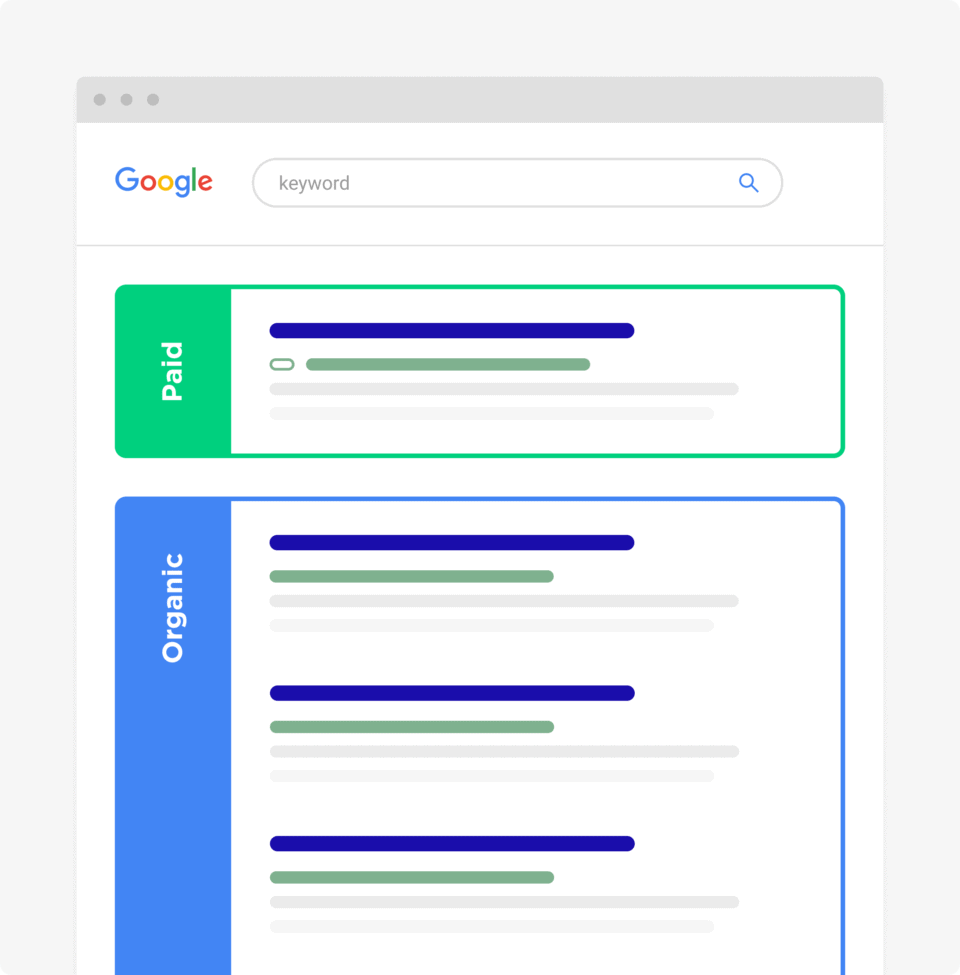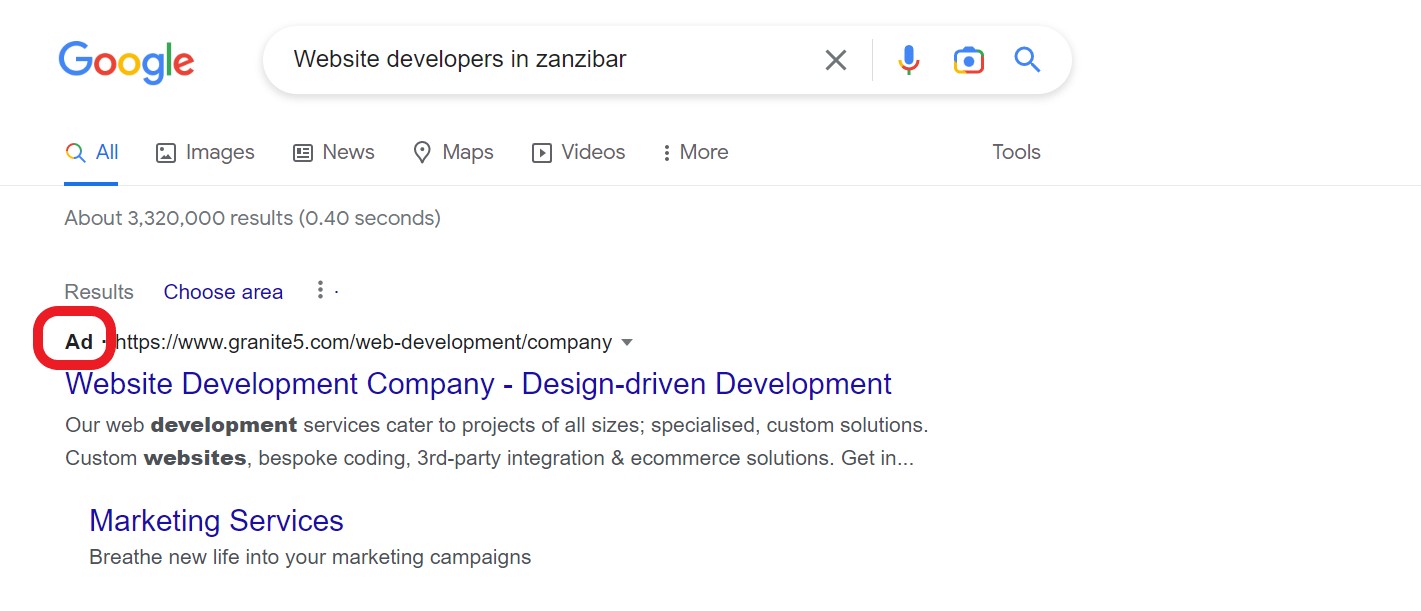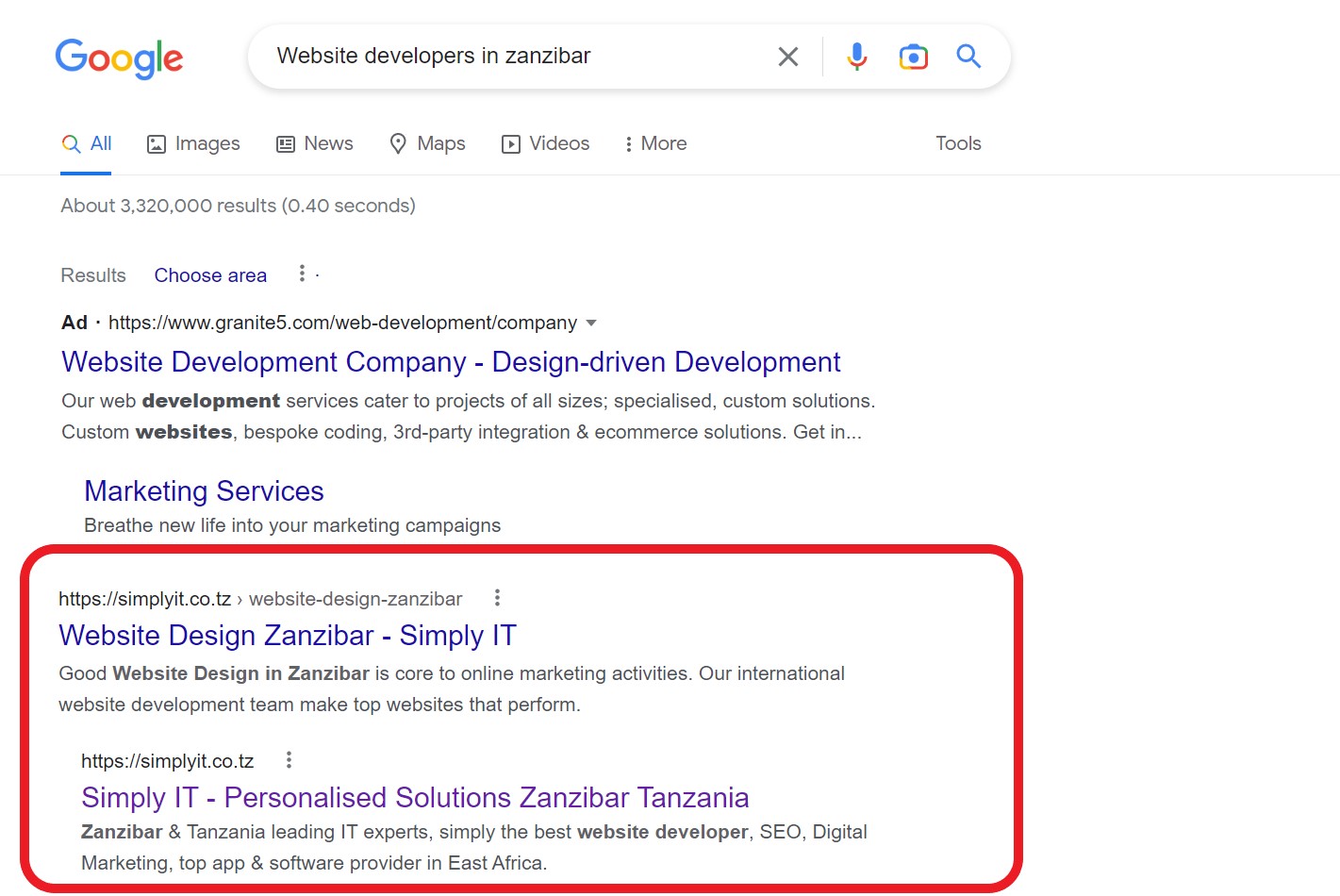
What are the Differences between SEO and SEM?

The primary distinction is that Search Engine Optimization (SEO) is concentrated on optimising a website in order to attract visitors from organic search results. The objective of Search Engine Marketing (SEM), on the other hand, is to increase traffic and visibility through both sponsored and organic searches.
To explain it another way:
The sponsored (paid) search results and the organic search results make up Google’s two primary types of search results.
So let’s look at the difference between SEO and SEM:
Should I do SEO or SEM for my online business strategy?
So, what are the differences between SEO & SEM? This is one of the most recurring questions from anyone starting their business on the Internet. The simple answer is; BOTH areas of digital marketing are important within a corporate strategy.
The truth is; both focus on getting more web-traffic and, consequently, a greater number of potential customers. However, despite the fact that both have a similar objective, the method with which they achieve it is completely different. This makes each discipline unique.
Now, the real question you should ask yourself is: does the difference between SEO and SEM prevent them from being used at the same time? Well the short answer is ‘no’. In fact, they can be combined to maximize your digital marketing plan, and your business in general.
SEO & SEM are Compatible Within a Digital Strategy?
Let’s start by answering the previous question, as I said, despite being two different disciplines, it does not mean that they are incompatible.
In fact, quite the opposite; Both “Search Engine Optimization” and SEM compliment each other, and in fact, it can be very beneficial to use both disciplines in the same online strategy.
Many people tend to be confused when talking about SEO or SEM , either because their initials are very similar, or because they both have the same objective, which is to get visibility and traffic.
Furthermore, once people realise they are different, often the next question is: which of the two is the best technique to promote my business on the Internet?
Just to clarify: I will not talk about which of the two is better, since both have their own advantages and disadvantages, which we will see later.
Therefore, the important thing is not which of the two is better, but which of the two is better adapted to certain situations .
Having clarified this query, let’s see what the differences between them are , and based on this, how it is possible to combine both to achieve a better positioning in the Google SERPs (Search Engine Results Pages).
Or:
What is the Difference Between SEO and SEM in Google Results?
Let’s start with the obvious visual difference, and that is that both SEO and “Search Engine Marketing” appear within Google’s results pages, and it is possible to differentiate them in a fairly simple way .
As you know SEO «Search Engine Optimization» seeks organic positioning. Increasing your ranking in the SERPs without paying Google for it, while in SEM «Search Engine Marketing» you pay to have greater visibility on the results page.
Fortunately, Google currently makes sure to tell you which of the results are paid ads and which are organically positioned there.
How can you identify them?
Very simple, through an «ad tag» next to the URL.

If we search for “ website developers in Zanzibar ” we see that the first results are paid ads, from Search Engine Marketing.
We know this thanks to the ” Announcement ” «ad tag» on the left of the URL.
Particularly for this keyword, which is quite competitive, there are several ads per search, so we will have to go down a bit until the ads disappear and we begin to see the organic results.

It is not until after a few ad results that we start to see the organic results, as you see, in this case the «ad tag» no longer appears next to the URL.
To be clear, this label is not the only big difference between organic and paid positioning.
If you carefully examine the screenshot, you’ll notice that the advertisements have descriptions that are especially brief since they feature calls to action—some even include a way to contact the company.
And, more importantly, unlike an organic result, which includes a specific Web page, the URL just includes the main domain.
There will not always be announcements of this style in the SERPs
To end this point, I want to clarify that ads, (the pages positioned through Google Ads) are much less common than you might think .
Generally, they tend to appear for highly competitive niches or for transactional keywords such as “best web designers in Tanzania”, so, if you are worried about not being able to reach the top spot because of the ads, let me tell you that this situation will rarely happen to you ; unless you’re in a highly competitive niche.
In addition, if the search that you carry out (you or another user) is purely informative, the appearance of an «ad tag» will be practically non-existent.
Here are 4 Differences Between SEO and SEM You Should Know
Since not everything is determined by the Google results page, let’s continue discussing the distinctions between SEO and SEM.
If you want to start utilising these two disciplines—or strategies—in your approach as effectively as possible, you should be aware of these key contrasts between them.
1. SEM is fast, but SEO is “Sustainable”
The first distinction I want you to be aware of is that SEO enables you to obtain results considerably more quickly than SEM.
It should come as no surprise that organic placement requires work; unlike paid promotion, it takes time to start seeing returns.
Sometimes a few months, in very competitive sectors, it can take 6 months or a year.
But remember, this can be acceptable because you are paying for long-term outcomes…
Do not fall into the trap of thinking that you should give SEM your undivided attention. The most certain way to succeed with your online business, even though it may be the slowest option, is through search engine optimization.
In the end, it all comes down to knowing how to balance both disciplines, taking advantage of one while investing time and effort in the other.
2. SEM is Simply Paying for Visibility

Another point you should know is that, unlike SEO, SEM requires investing money in ads to give visibility to your site .
The investment may vary depending on the type of ad, the results and how you program the campaign, but you will always have to pay to start an advertising campaign.
3. You Invest More Time in SEO and more Money in SEM
Organic positioning also entails resources and investments. However, in the long run it will be a good investment.
Be careful because nothing is for free!
In the long term, SEO costs can be nearly as high as SEM’s so always look carefully at results. Especially if you are paying a 3rd-party to do SEO or SEM. Always insist on seeing the progress and regular reporting of the results.
Since organic visibility drives us to spend resources—including people, time, and money—into our plans, I’m not just talking about financial investments here.
Numerous talents and a significant amount of “field” effort are necessary for organic visibility:
Slowly but surely, time, money, and effort can add up to the point where organic visibility tasks practically equal Google Ads in terms of total investment. So to counter this, always make sure you keep adding new keywords, to your website. Once you are ranking in the top 5 on Google for a group of keywords, then carefully research and select another group of keywords (usually a half a dozen at a time is good). At Simply IT we target 6-12 keywords every year and once these rank well, we then move onto another 6-12 keywords. This way you are not wasting time or resources on SEO when you already have reached your goals or there are better keywords to target. Always get good, reliable and regular feedback and reports on the ranking and visibility of your keywords, so you know exactly what is being achieved. This is good use of your SEO investment.

4. Once a Campaign Ends, Paid Advertising Stops Working!
While organic gives you more constant and “permanent” results (as long as the search engine considers that your content is relevant enough for the user), once the advertising campaign you paid for ends, the SEM stops giving results, at least until you start paying for more advertising.
Again, it is normal, and it is that here you pay to see results, so if you do not invest, you will not have online visibility.
How Do I Combine SEO and SEM in a Digital Marketing Strategy?

Lastly, let’s talk about how you can combine both digital marketing techniques.
And for this I will give you some tips and strategies that you can apply and that will help you take advantage of both disciplines to get more visibility on Google:
»Who Says You Need To Wait A While To Start Seeing Results?
If it is true that with «Search Engine Optimization» you need time to start seeing results, but the same does not happen with SEM.
Therefore, while strengthening and optimizing the former, why not take advantage of the rapid results of the other?
So not only will you be working to achieve a better organic positioning in the medium and long term, but you will also start giving visibility to your Blog, business or brand in the short term thanks to the ads.
In this case we could say that SEM is going to sustain and drive the first moments of “Search Engine Optimization” and your website, like a baby walker who is just beginning to walk.
Of course, it is recommended that you look for a specialist to help you optimize your ads to have better results and that you can recover your initial investment.
»Take Advantage Of The Market Research Of One To Optimize The Other
It is evident that thorough market research is required to develop a successful campaign, such as Google Ads, which includes researching possible keywords, the competition, and other factors.
This data can be utilized to improve your organic strategy in addition to your paid Google advertisements.
You already know what your competitors are up to, what prospective keywords you might use, and how to optimise your snippets.
The moment has come to make use of this knowledge and build an organic strategy around it.
Since the data you get for one may be used for the other and vice versa, both work wonderfully together in this sense.
»If Your Market is Globally Competitive, Try Using Multiple Languages

Multilingual SEO is definitely the way forward to get an edge on your competitors and drive traffic and revenue by translating your website content into other languages. To find out how this works check out our Knowledgebase article on Multi-Language SEO and how it could benefit you.
»If Your Market is Competitive, use Paid Advertising

The best medium- and long-term positioning for your website is organic positioning.
However, there are niche industries where the competition is extremely fierce, making it necessary for you to wait months or even years before you start to see benefits.
Don’t be hesitant to use SEM in situations with intense competition because it will be the only way to get results faster while still focusing on organic positioning.
Even if you put twice as much time and effort into SEO, you still won’t be able to compete in a crowded niche without the direct assistance that only SEM can provide.
Although I do caution you that in a highly competitive niche you will also need to invest twice as much money as you would typically use for a campaign, often even more, just as you need to put twice as much time and effort in organic.
»Focus on SEO for Content and Build Brand while Boosting Sales with SEM
Generally, when a user performs a search, we can distinguish three possible intentions, that of searching for information, carrying out a transaction or finding a company, brand or institution.
It is possible to differentiate the search intention based on the type of keyword they use, be it informative to search for information, transactional to make a purchase or sale, or navigational if their intention is to find a specific website.
Conclusion
To sum up, we could say that positioning informative or navigational keywords is easier when the user is seeking information without a specific purchase goal or already knows what site they are looking for because the user will be more direct and search for the name of the brand, company, or institution in these circumstances.
As a result, organic tends to be the most effective way to position our brand and informational material in addition to selling goods and services.
The SEM, on the other hand, is ideal for transactional keywords and to drive quick sales because organic search is typically considerably more competitive for terms that indicate a transactional intention on the part of the user.
And yet they won’t have a specific web-page in mind while they carry out a planned action.
Let Simply IT handle your Digital Marketing strategy
Simply IT can take a hands-on role in your SEO or SEM, or we can simply advise you. Either way you can guarantee online marketing results that exceed your expectations.
Tell Simply IT website designers and website developers about your brand, your voice and what you plan to achieve with your business.
The more information we have, the more equipped we are to deliver the perfect SEO or SEM strategies that work for you. We have over 30 happy clients in Zanzibar, Tanzania, East Africa, Asia and Europe.






